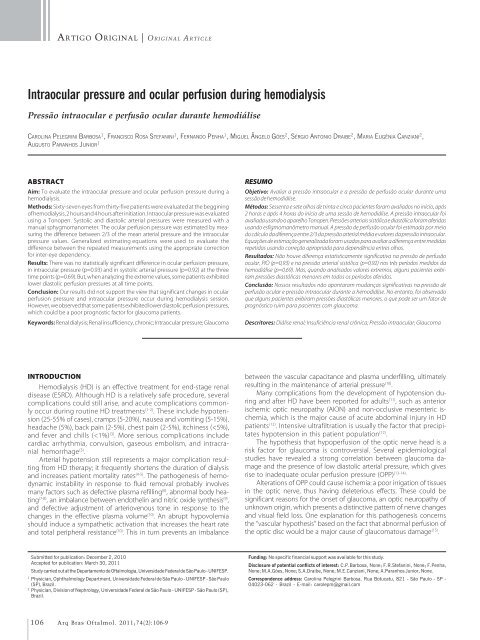a rquivos b rasileiros - Conselho Brasileiro de Oftalmologia
a rquivos b rasileiros - Conselho Brasileiro de Oftalmologia
a rquivos b rasileiros - Conselho Brasileiro de Oftalmologia
Create successful ePaper yourself
Turn your PDF publications into a flip-book with our unique Google optimized e-Paper software.
ARTIGO ORIGINAL | ORIGINAL ARTICLE<br />
Intraocular pressure and ocular perfusion during hemodialysis<br />
Pressão intraocular e perfusão ocular durante hemodiálise<br />
CAROLINA PELEGRINI BARBOSA 1 , FRANCISCO ROSA STEFANINI 1 , FERNANDO PENHA 1 , MIGUEL ÂNGELO GÓES 2 , SÉRGIO ANTONIO DRAIBE 2 , MARIA EUGÊNIA CANZIANI 2 ,<br />
AUGUSTO PARANHOS JUNIOR 1<br />
ABSTRACT<br />
Aim: To evaluate the intraocular pressure and ocular perfusion pressure during a<br />
hemodialysis.<br />
Methods: Sixty-seven eyes from thirty-five patients were evaluated at the beggining<br />
of hemodialysis, 2 hours and 4 hours after initiation. Intraocular pressure was evaluated<br />
using a Tonopen. Systolic and diastolic arterial pressures were measured with a<br />
manual sphygmomanometer. The ocular perfusion pressure was estimated by measuring<br />
the difference between 2/3 of the mean arterial pressure and the intraocular<br />
pressure values. Generalized estimating equations were used to evaluate the<br />
difference between the repeated measurements using the appropriate correction<br />
for inter-eye <strong>de</strong>pen<strong>de</strong>ncy.<br />
Results: There was no statistically significant difference in ocular perfusion pressure,<br />
in intraocular pressure (p=0.93) and in systolic arterial pressure (p=0.92) at the three<br />
time points (p=0.69). But, when analyzing the extreme values, some patients exhibited<br />
lower diastolic perfusion pressures at all time points.<br />
Conclusion: Our results did not support the view that significant changes in ocular<br />
perfusion pressure and intraocular pressure occur during hemodialysis session.<br />
However, we observed that some patients exhibited lower diastolic perfusion pressures,<br />
which could be a poor prognostic factor for glaucoma patients.<br />
Keywords: Renal dialysis; Renal insufficiency, chronic; Intraocular pressure; Glaucoma<br />
RESUMO<br />
Objetivo: Avaliar a pressão intraocular e a pressão <strong>de</strong> perfusão ocular durante uma<br />
sessão <strong>de</strong> hemodiálise.<br />
Métodos: Sessenta e sete olhos <strong>de</strong> trinta e cinco pacientes foram avaliados no início, após<br />
2 horas e após 4 horas do início <strong>de</strong> uma sessão <strong>de</strong> hemodiálise. A pressão intraocular foi<br />
avaliada usando o aparelho Tonopen. Pressões arteriais sistólica e diastólica foram aferidas<br />
usando esfigmomanômetro manual. A pressão <strong>de</strong> perfusão ocular foi estimada por meio<br />
do cálculo da diferença entre 2/3 da pressão arterial média e valores da pressão intraocular.<br />
Equações <strong>de</strong> estimação generalizada foram usadas para avaliar a diferença entre medidas<br />
repetidas usando correção apropriada para <strong>de</strong>pendência entres olhos.<br />
Resultados: Não houve diferença estatisticamente significativa na pressão <strong>de</strong> perfusão<br />
ocular, PIO (p=0,93) e na pressão arterial sistólica (p=0,92) nos três períodos medidos da<br />
hemodiálise (p=0,69). Mas, quando analisados valores extremos, alguns pacientes exibiram<br />
pressões diastólicas menores em todos os períodos aferidos.<br />
Conclusão: Nossos resultados não apontaram mudanças significativas na pressão <strong>de</strong><br />
perfusão ocular e pressão intraocular durante a hemodiálise. No entanto, foi observado<br />
que alguns pacientes exibiram pressões diastólicas menores, o que po<strong>de</strong> ser um fator <strong>de</strong><br />
prognóstico ruim para pacientes com glaucoma.<br />
Descritores: Diálise renal; Insuficiência renal crônica; Pressão intraocular; Glaucoma<br />
INTRODUCTION<br />
Hemodialysis (HD) is an effective treatment for end-stage renal<br />
disease (ESRD). Although HD is a relatively safe procedure, several<br />
complications could still arise, and acute complications commonly<br />
occur during routine HD treatments (1-2) . These inclu<strong>de</strong> hypotension<br />
(25-55% of cases), cramps (5-20%), nausea and vomiting (5-15%),<br />
headache (5%), back pain (2-5%), chest pain (2-5%), itchiness (

















